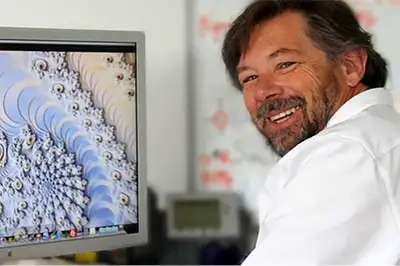
Fascination Science - a free lecture series in Albany.
Have you ever considered that our nation’s iconic silver fern is in fact a mathematical oddity known as a fractal? The fifth instalment of a free lecture series held at the Massey University’s Albany campus will explore the world around us that goes unnoticed.
Distinguished Professor Gaven Martin, of the New Zealand Institute for Advanced Study, has made a name for himself by finding answers to some of the most puzzling questions that underpin our understanding of how the physical world works.
The lecture is part of the ‘Fascination Science’ series and will look at the wonder of fractals in mathematics and how they can help us understand the natural world.

Distinguished Professor Gaven Martin.
Pure Mathematics
A strong advocate of the study of pure mathematics, Professor Martin, says you don’t have to be a mathematician to grasp these ideas.
“Fractals and fractal structures are abundant in nature, where small scale symmetries are repeated at ever larger scales, or large scale symmetries are repeated at ever finer detail. We can see these things in natural objects at all scales – from snowflakes, trees, our cardiovascular system, and landscapes right up to galaxies. In Mandelbrot’s words ‘Nature exhibits not simply a higher degree but an altogether
different level of complexity’ These theories are how mathematicians come to grips with this complexity.
“In fact the mathematical concepts are difficult to define formally even for mathematicians, but key features, such as self-similarity, where an object is the shame shape as the parts that make up that shape, can be understood with little mathematical background.
“In this lecture we will discuss what these are, along with the notion of fractional dimensions (a measure of the scaling properties of an object) and emergent structures in dynamical systems,” Professor Martin says.
Mandelbrot set
Professor Martin will also explore the Mandelbrot set, an image that many of us will have seen, but not all of us will have appreciated the deep mathematical structures that it encodes.
“While you can observe fractals in nature, the stunning images of the Mandelbrot set are things undreamt of by mathematicians until modern computers showed us these structures, opened up new branches of mathematics and revitalised some old ones. In fact, the computational exploration of dynamical systems is now revealing ever greater complexity in the real world and our models of it,” Professor Martin says.
Mathematical understanding of this complexity leads to more useful applications and so Professor Martin will discuss the remarkable fractal Lorenz Butterfly (giving rise to the term the butterfly effect). This object comes naturally from simple models of weather prediction and shows fractal structures naturally arising in chaotic systems.
If you have ever really wondered what these objects really are – come along and find out.
Lecture details
Mandelbrot and fractals: the geometry of chaos
Tuesday, May 30, 7.00-8.30pm, Sir Neil Waters Lecture Theatres, Massey University Auckland Campus, Albany.
For more information or to register to attend, go to http://massey.ac.nz/fascination-science